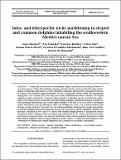Por favor, use este identificador para citar o enlazar a este item:
http://hdl.handle.net/10261/158311COMPARTIR / EXPORTAR:
 SHARE SHARE
 CORE
BASE CORE
BASE
|
|
| Visualizar otros formatos: MARC | Dublin Core | RDF | ORE | MODS | METS | DIDL | DATACITE | |

| Título: | Intra-and interspecific niche partitioning in striped and common dolphins inhabiting the southwestern Mediterranean Sea |
Autor: | Giménez, Joan CSIC ORCID ; Cañadas, Ana; Ramírez Benítez, Francisco CSIC ORCID CVN ; Afán, Isabel CSIC ORCID ; García-Tiscar, Susana; Fernández-Maldonado, Carolina; Castillo, Juan José; de Stephanis, Renaud CSIC ORCID | Palabras clave: | Spatial modelling Stable isotopes Stenella coeruleoalba Segregation Niche partitioning Co-occurring species Delphinus delphis |
Fecha de publicación: | 2017 | Editor: | Inter Research | Citación: | Marine Ecology - Progress Series 567: 199- 210 (2017) | Resumen: | Community structure and functioning is shaped by resource partitioning between cooccurring species. Niche differentiation among sympatric species can be reached through trophic, spatial or temporal segregation to avoid competitive exclusion. Intraspecific segregation in the use of habitats and resources might determine, in turn, a population's niche width and interspecific segregation. The Alboran Sea is the only area in the Mediterranean where common and striped dolphins coexist abundantly. Therefore, these putative competing species provided the opportunity to investigate niche partitioning through spatial modelling and trophic analysis. Density surface modelling and nitrogen and carbon stable isotopes (δN and δC) were used to investigate spatial and trophic niche partitioning at inter-and intraspecific levels. The 2 species showed high isotopic overlap. However, we could not rule out the possibility of interspecific trophic segregation, as isotopic similarity does not necessarily mean true ecological or dietary similarity. Among conspecifics, variations in δN and δC values with dolphin length pointed to ontogenetic dietary changes in striped dolphins, while sex played only a minor role in δC values. Spatially, these species tended to segregate their core areas of distribution, with common dolphins being more coastal than striped dolphins, which occupied adjacent, deeper waters. Overall, the main enabler for the coexistence of common and striped dolphins in the Alboran Sea was spatial segregation. | URI: | http://hdl.handle.net/10261/158311 | DOI: | 10.3354/meps12046 | Identificadores: | doi: 10.3354/meps12046 issn: 0171-8630 |
| Aparece en las colecciones: | (EBD) Artículos |
Ficheros en este ítem:
| Fichero | Descripción | Tamaño | Formato | |
|---|---|---|---|---|
| Giménez et al 2017 MEPS.pdf | 1,69 MB | Adobe PDF |  Visualizar/Abrir |
CORE Recommender
SCOPUSTM
Citations
35
checked on 13-abr-2024
WEB OF SCIENCETM
Citations
33
checked on 28-feb-2024
Page view(s)
554
checked on 23-abr-2024
Download(s)
518
checked on 23-abr-2024
Google ScholarTM
Check
Altmetric
Altmetric
NOTA: Los ítems de Digital.CSIC están protegidos por copyright, con todos los derechos reservados, a menos que se indique lo contrario.
